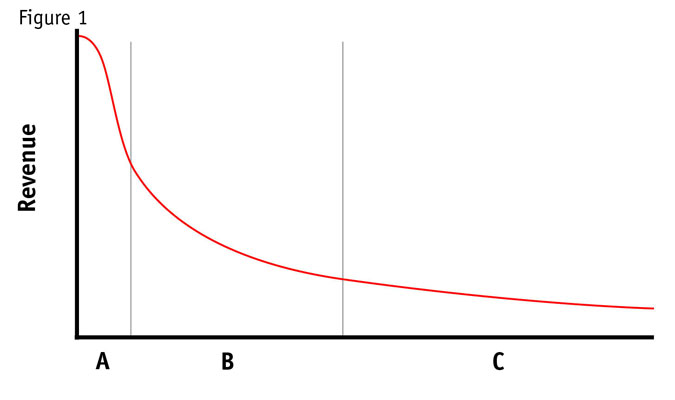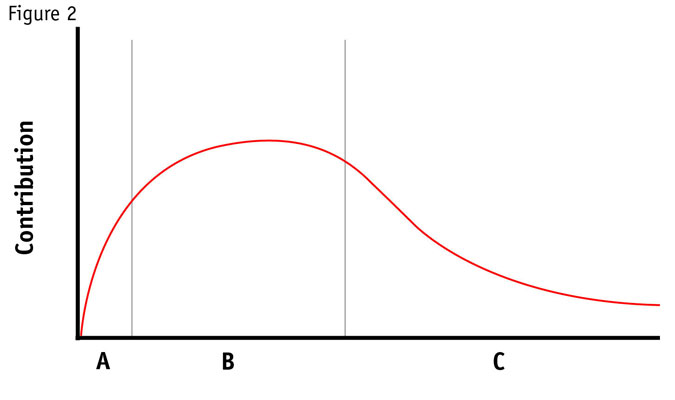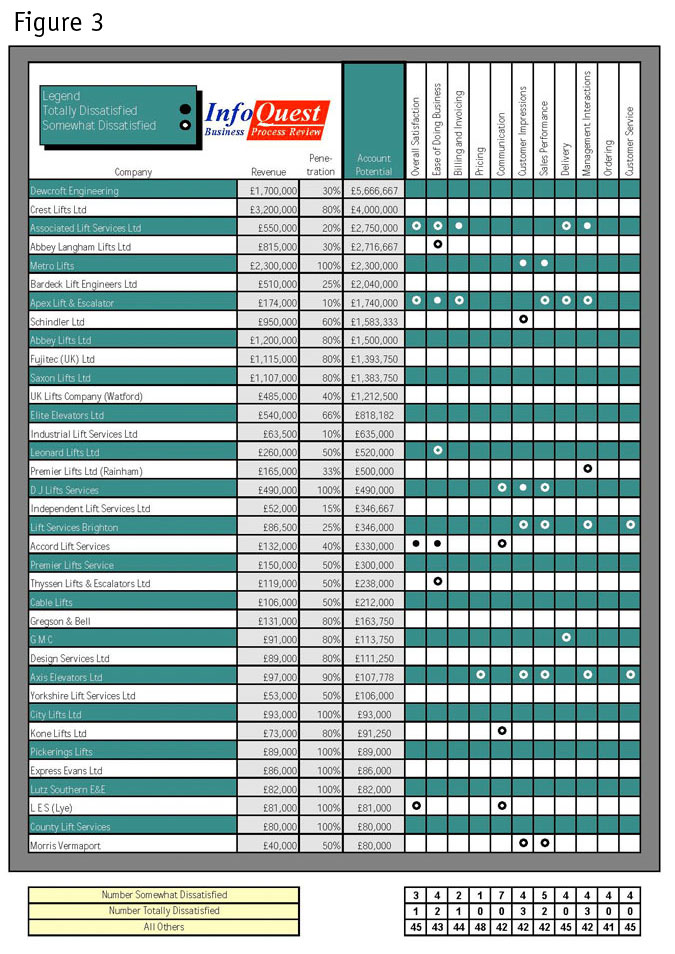Editor's note: John Coldwell is managing director, U.K., of InfoQuest CRM Ltd., a Huddersfield, U.K., research company. He can be reached at jc@infoquestcrm.co.uk. This article appeared in the April 24, 2012, edition of Quirk's e-newsletter.
I believe that the most valuable asset B2B organizations have is their customer base and that many would benefit from checking in with customers regularly to measure satisfaction. In B2B, our typical client will have anywhere from a couple hundred to a couple thousand customers and conducting research is an effective way to manage those relationships. A successful B2B customer satisfaction survey includes the most important customers but, unfortunately, many B2B organizations don't really know who these customers are.
In an ideal world, the list of the most important customers for a satisfaction survey should contain a mix of the most profitable accounts and current customers who haven't yet reached their full potential. If our client uses activity-based costing (ABC), where overheads and indirect costs are allocated to the cost of producing the goods and servicing the customers, then identifying the most profitable accounts should be relatively straightforward. But, not surprisingly, the vast majority of our clients are unable to do this. So here are some of the methods we use to help them.
Identifying the most profitable
One suggestion is to get the key account managers (KAMs) to choose who they think the most important customers are. The proposal is simple. Let's say the client has 200 customers and five KAMs. Pretend it's Christmas and each of the KAMs have two dozen bottles of the finest Scotch whiskey to gift to customers. Ask the KAMs to whom they would give the bottles. This exercise is dangerous in that they might give the bottles to their friends (i.e., customers they visit on a Friday afternoon for a round of golf, customers they've known for years, customers described as cash cows, etc.) but that analysis in itself can be eye-opening. Regardless of which customers the KAMs choose, this process positively engages the salespeople who, quite understandably, see a customer survey as a threat.
Another technique is to look at the revenue generated by the overall customer base and apply the Pareto principle, also known as the 80-20 rule. Most B2B businesses have a customer profile similar to the one depicted in the figure below.
Figure 1 shows some very large customers (less than 10 percent) known as the As, who are the major buyers of the client's goods and services. The Bs and Cs are average- and smaller-sized customers, respectively.

Figure 2 then looks at how A, B and C customers might appear if they were displayed on a contribution curve.

The A customers know the power of their spending. They buy as though they are buying a commodity rather than a value-added item. The extra demands from large customers can include special packaging, special deliveries, stock-holding, extra-long credit terms, days out playing golf - all on top of discounted prices. These extra costs regularly turn A customers into marginal accounts.
However, the A customers are needed. They deliver the volumes required to gain the economies of scale, without which the client couldn't service the B customers.
My advice is to carry out customer satisfaction surveys with A and B customers. The A customers need to be surveyed to identify if any are considering taking their business elsewhere. If so, news of the migration could get out, perhaps leaked to the trade press, and some B or C customers might follow without knowing the full story. Needless to say, that would be very bad.
The B customers need to be surveyed so that more can be sold to them. This is where the profit comes from. This is where our clients should be looking for references, referrals, case studies, cross-selling, upselling and more business. The C customers, though not included in the survey, also won't be left out; they will benefit from the generic improvements made to the systems, disciplines and procedures for the As and Bs.
Identifying customers with potential
Once you have a system in place for identifying and surveying the most profitable accounts, it's time to consider the customers with the most potential. This is the second group of customers that should be included in a B2B customer satisfaction survey. They need to be existing customers (so as to have a valid opinion) so the quickest and easiest way to see if your client has any low-hanging fruit is to ask clients to provide a list of the top 20 or 30 accounts by sales revenue for each KAM. Then, gather the KAMs together in one room. (Make sure that the door to the room has a lock on it - this is important.)
The KAMs should know their top accounts inside-out (i.e., who takes sugar, who prefers tea, what sports they follow, etc.) so it should be relatively easy for them to run down the list and speculate the level of penetration (or share-of-wallet) the client has with each account. One way to frame this exercise is to ask, "How much of their business do we have that we want? All of it? Eighty percent? Fifty percent? Twenty percent? Go on, take a guess. No, you're not leaving until you tell me. And I've locked the door."
Once you have that figure - and it's not easy getting it - take the revenue (say $100) and divide it by the percentage figure (say 25 percent). That will give you the potential (in this case $400). Figure 3 shows a typical example of how you can use account potential.

Two customers stand out as having low-hanging fruit: Dewcroft Engineering with 30 percent penetration and no issues; and Abbey Langham Lifts, also with 30 percent penetration but with a slight issue regarding the ease of doing business. Here, the KAMs should be sent out to the customers and not allowed back in the office until the share-of-wallet is up to at least 60 percent.
There's another opportunity shown in Figure 3. Both Associated Lift Services and Apex Lift & Escalator have several issues. Resolution might lie in clients changing their systems, disciplines and procedures to bring them in line with customer needs. Or the client may prefer to wait for the buyers at these two firms to get promoted, retire or be run over by a bus. My advice is to change the KAMs that currently take care of these two accounts because, to me, it looks as though there could be a personality clash. I'd suggest trying it for six months and seeing if those problems disappear.
Validating the list
Finally, once you have a compiled complete list of customers who should be included in a satisfaction survey, allow for extra time to validate the list. Much of the customer data we are given is awful. When I say awful, I'm thinking of a recent project of 150 customers where three customers had been given sex changes (i.e., Mr. instead of Mrs. and vice versa). In another project, upwards of 75 percent of the customer data had serious errors. Too much effort went in to finding the ideal respondents to throw it away with a mistake as easily avoidable as addressing a Mr. as a Mrs. or leading with an impersonal "Hi" instead of "Hi John" or "Dear Mr. Coldwell."
To start the validation process, our clients choose who they want to include in the survey and then send a personal (and personable) letter asking them to participate. We then telephone the targets to 1) ask if they've received the letter, 2) ask whether they are willing to take part and then 3) check to make sure we have the correct contact details, including the spelling of their name and their mailing address. If there are any changes to be made to the contact details, we highlight the differences in the report that goes back to the client at the end of the process.
Quality of respondents
Ultimately, the strength of a B2B customer satisfaction survey depends largely on the quality of respondents. Using these strategies to identify the most important customers in terms of both profitability and potential can help cultivate the best group customer possible and therefore the best data off which to create a business plan.
